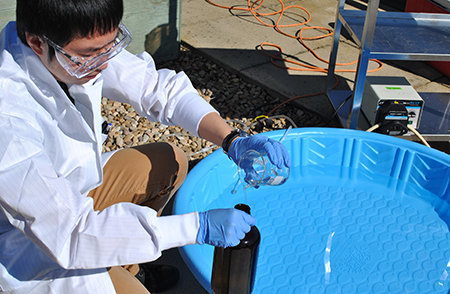Researchers discover solar energy-driven process makes tailings ponds reclamation instant

Civil engineering graduate student Zengquan Shu simulates the solar UV/chlorine treatment process. Laboratory-scale tests found the solar UV/chlorine treatment process removed 75 to 84 per cent of the toxins found in tailings ponds.
Instead of using UV lamps as a light source to treat oil sands process affected water (OSPW) retained in tailings ponds, professors Mohamed Gamal El-Din and James Bolton have found that using the sunlight as a renewable energy source treats the wastewater just as efficiently but at a much lower cost.
“We know it works, so now the challenge is to transfer it into the field,” says Gamal El-Din, who also worked on the project with graduate students Zengquan Shu, Chao Li, post doctorate fellow Arvinder Singh and biological sciences professor Miodrag Belosevic.
“This alternative process not only addresses the need for managing these tailings ponds, but it may further be applied to treat municipal wastewater as well. Being a solar-driven process, the cost would be minimal compared to what’s being used in the field now.”
Oilsands tailings ponds contain a mixture of suspended solids, salts, and other dissolvable compounds like benzene, acids, and hydrocarbons. Typically, these tailings ponds take 20 plus years before they can be reclaimed. The solar UV/chlorine treatment process when applied to the tailings ponds would make OSPW decontamination and detoxification immediate.
The sun’s energy will partially remove these organic contaminants due to the direct sunlight. But, when the sunlight reacts with the chlorine (or bleach) added to the wastewater, it produces hydroxyl radicals (powerful oxidative reagents) that remove the remaining toxins more efficiently. The chlorine leaves no residuals as the sunlight causes it to decompose.
In laboratory-scale tests the solar UV/chlorine treatment process was found to remove 75 to 84 per cent of these toxins.
“With this solar process, right now, the wastewater on the top of the tailings ponds is being treated. But because we have nothing in place at the moment to circulate the water, the process isn’t being applied to the rest of the pond,” says Gamal El-Din.
“Because we are limited by the sunlight’s penetration of the water, we now must come up with an innovative design for a mixing system like rafts floating on the ponds that would circulate the water. Installing this would still be much more cost effective for companies. It is expected that the UV/chlorine process will treat the OSPW to the point that the effluent can be fed to a municipal wastewater treatment plant, which will then complete the purification process sufficiently so the water can be discharged safely into rivers.
“This process has been gaining a lot of attention from the oil sands industry. We’re now seeking funds for a pilot-pant demonstration and are looking at commercializing the technology.”
Their findings were published in the Environmental Science & Technology journal.
This research was funded by Trojan Technologies, NSERC Collaborative Research and Development (CRD) grant, Alberta Innovates-Energy and Environment Solutions, and Helmholtz-Alberta Initiative (HAI).
Media Contact
More Information:
http://www.civil.engineering.ualberta.ca/en/NewsEventsAll latest news from the category: Ecology, The Environment and Conservation
This complex theme deals primarily with interactions between organisms and the environmental factors that impact them, but to a greater extent between individual inanimate environmental factors.
innovations-report offers informative reports and articles on topics such as climate protection, landscape conservation, ecological systems, wildlife and nature parks and ecosystem efficiency and balance.
Newest articles

Silicon Carbide Innovation Alliance to drive industrial-scale semiconductor work
Known for its ability to withstand extreme environments and high voltages, silicon carbide (SiC) is a semiconducting material made up of silicon and carbon atoms arranged into crystals that is…

New SPECT/CT technique shows impressive biomarker identification
…offers increased access for prostate cancer patients. A novel SPECT/CT acquisition method can accurately detect radiopharmaceutical biodistribution in a convenient manner for prostate cancer patients, opening the door for more…

How 3D printers can give robots a soft touch
Soft skin coverings and touch sensors have emerged as a promising feature for robots that are both safer and more intuitive for human interaction, but they are expensive and difficult…





















